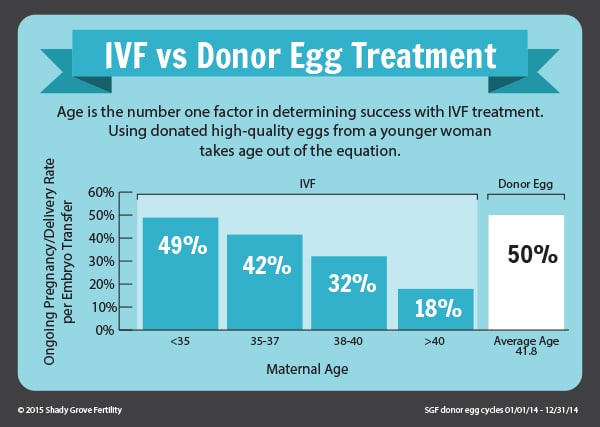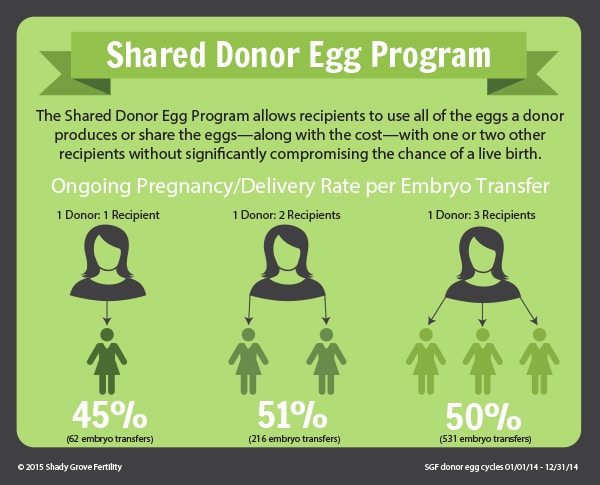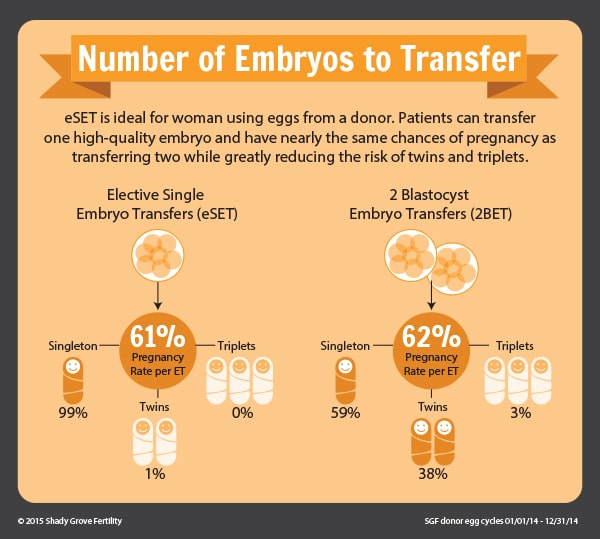With over 1,000 initiated fresh and frozen donor egg cycles, Shady Grove Fertility’s Donor Egg Program continues to grow and produce the highest success rates for patients of all treatment types. While many patients may not need donor egg treatment, if you are considering it, it’s important to understand the success rates and their impact on your fertility treatment. Read the FAQs about our Donor Egg Program.
What is the difference between IVF and donor egg treatment?
While both in vitro fertilization (IVF) and donor egg treatment are very similar and use the same medical processes, the source of the eggs used is the differentiating factor between the two treatments. Generally, when a patient undergoes IVF treatment, the intent is to use her own eggs—this is known as autologous IVF. For others, especially women whose infertility is caused by a decrease in ovarian reserve and function, using eggs that another woman donated is an effective form of treatment. Decreased ovarian reserve is a problem that can occur at any age, but is much more common in women in their late 30s and 40s. Fortunately, for women unable to conceive using their own eggs, donor egg treatment offers the highest pregnancy and delivery rates of any fertility treatment and still allows the woman to carry a child.
How do donor egg treatment success rates compare to IVF success rates?
Depending on your age, the difference in success between autologous IVF and IVF using donated eggs can be significant. The chart below shows the ongoing pregnancy per embryo transfer (ET) rate by age (this is a pregnancy reaching 20 weeks gestation or delivery). It is typical to see a continual decrease in ongoing pregnancy as a woman ages.
Using donor eggs from an egg donor (ages 21 to 32) takes your age essentially out of the equation and increases your chances of success. As a result, in 2014, women late in their reproductive years (older than 40 years) experienced a 50 percent ongoing pregnancy per embryo transfer rate versus an 18 percent success rate when using their own eggs.

What is Shady Grove Fertility’s exclusive Shared Donor Egg Program and how does it impact my chances of getting pregnant?
Shady Grove Fertility’s Shared Donor Egg Program significantly increases the number of patients that are able to access donor egg treatment by reducing the cost of treatment by nearly 50 percent for patients who participate in the 1:3 program. After reviewing traditional donor egg treatment cycles—in which one donor donated her eggs to one recipient—the data demonstrated that donors developed more mature eggs than one recipient would ever be able to use. With donors producing 18 eggs on average, we recognized that recipients could share the eggs from a single donor—this program changed the playing field and made conception with donor egg treatment affordable for many more of our patients.
With the Shared Donor Egg Program, recipients can opt to share the eggs a donor produces, as well as the cost with one or two other couples.
One of the many questions patients considering the Shared Donor Egg program have is, “If I share donated eggs with another couple, will it decrease my chances of taking home a baby?” We assure our patients that success rates for this program remain very similar with traditional donor egg treatment.
How does Shady Grove Fertility’s Shared RISK 100% Risk 100% Refund Program work with donor egg treatment?

Unfortunately, many insurance companies do not cover the cost of this expensive, yet highly successful, treatment option. To help ease the financial burden for patients, our Shared Risk 100% Refund Program allows the patient to undergo up to 6 cycles of donor egg treatment as well as any subsequent frozen embryo transfer (FET) cycles. Should you not deliver a baby or you opt to leave the program which you can do at any point, we will issue a 100 percent refund (some exclusions apply). You may combine the Shared Risk 100% Refund Program with the Shared Donor Egg Program for additional savings. For those patients actively serving in the U.S. military, the Shady Grove Fertility Military Discount can also be used for greater savings.
How many embryos should I transfer? Will transferring two or more increase my chances of taking home a baby?
Shady Grove Fertility’s Donor Egg Program requires donors to be between the ages of 21 and 32, a population that experiences the highest pregnancy and live birth rates. For many women using donated eggs, our physicians will recommend transferring a single blastocyst-stage embryo, also called elective single embryo transfer (eSET). This is in contrast, perhaps, to transferring two or more embryos that may have been typical for women over 36 years of age when using their own eggs. Deciding to transfer only one embryo may feel very risky, however, because recipients are using high-quality eggs from a younger donor, the data has shown that transferring more than one high-quality embryo increases the chance of high-risk multiples, and only has a slight increase in pregnancy rates.

Deciding to move to donor egg treatment may not be easy. However, we encourage you to consider this treatment approach from all angles and take into consideration the high success rates as part of your decision-making process. Being well informed will help you make the decision that is right for you.
To learn more about Shady Grove Fertility’s Donor Egg Program or to schedule a new patient appointment, please call our New Patient Center at 877-971-7755.

